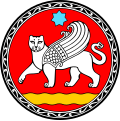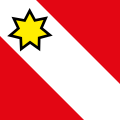This article includes a list of general references, but it lacks sufficient corresponding inline citations .(April 2011) |
| Regular heptagram (7/2) | |
|---|---|
 A regular heptagram | |
| Type | Regular star polygon |
| Edges and vertices | 7 |
| Schläfli symbol | {7/2} |
| Coxeter–Dynkin diagrams | |
| Symmetry group | Dihedral (D7) |
| Internal angle (degrees) | ≈77.143° |
| Properties | star, cyclic, equilateral, isogonal, isotoxal |
| Dual polygon | self |
| Regular heptagram (7/3) | |
|---|---|
 A regular heptagram | |
| Type | Regular star polygon |
| Edges and vertices | 7 |
| Schläfli symbol | {7/3} |
| Coxeter–Dynkin diagrams | |
| Symmetry group | Dihedral (D7) |
| Internal angle (degrees) | ≈25.714° |
| Properties | star, cyclic, equilateral, isogonal, isotoxal |
| Dual polygon | self |
| Star polygons |
|---|
A heptagram, septagram, septegram or septogram is a seven-point star drawn with seven straight strokes.
Contents
- Geometry
- Uses
- Flags and heraldry
- Law enforcement
- Religious and occult symbolism
- In popular culture
- Variants
- See also
- References
- External links
The name heptagram combines a numeral prefix, hepta- , with the Greek suffix -gram . The -gram suffix derives from γραμμῆ (grammē) meaning a line. [1]

















![Seal of Babalon and the A[?]A[?] Babalon seal.png](http://upload.wikimedia.org/wikipedia/commons/7/76/Babalon_seal.png)

